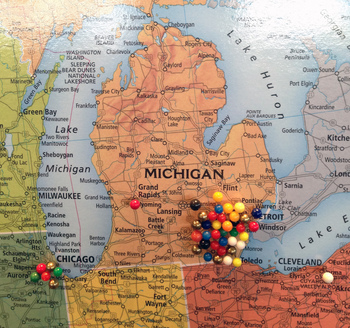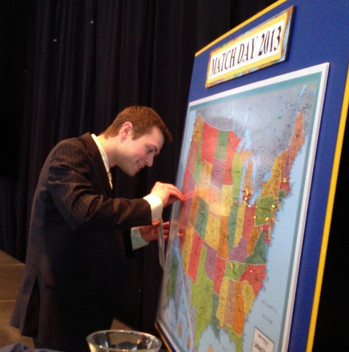Match Day 2013 for U-M medical school students: One-third will stay in Michigan
At the mercy of a computer algorithm used to determine residency placements, 161 University of Michigan Medical School students’ emotions and nerves were torqued to the maximum Friday as they waited for noon.
At noon, they were handed a white envelope.
Inside that envelope lay the answer for which the students had been waiting for months: The placement for their residency, where they would spend the next chapter of their lives as doctors.
It’s practice nationally to announce residency appointments on "Match Day," at the same time on the same day.
At U-M, it’s made into a celebration of the students’ accomplishments over their time at the school. If they choose, the students can announce their placements on stage during the event.

Pins graduating U-M Medical School students placed on a map Friday showing where they were placed for their residency. One-third will stay in Michigan -- the majority of which will be at U-M.
Amy Biolchini | AnnArbor.com
Beaming and electrified with excitement, Andrea Knittel, 30, of Ferndale read off her placement in front of a crowd of her fellow graduates Friday afternoon at a conference room in Building 18 of the North Campus Research Complex.
It was her top choice: The University of California - San Francisco for a specialty in OB/GYN.
Knittel has been studying at U-M for 12 years. Starting as an undergraduate student, the top programs and experience kept her at U-M through her advanced studies, Knittel said.
She’s among the 28 students in her graduating class to leave U-M with two degrees: Knittel completed a Ph.D. program in public health in addition to medical school.
The computerized system tabulates the placements based on a list of preferred candidates each program submits and on a ranking each student submits on where they want to go out of the institutions where they had interviews. Each residency program at a hospital has a fixed number of slots that they need to fill each year.
Dr. Raj Mangrulkar, associate dean for Medical Student Education at U-M, said the algorithm puts students in the best place for them based on the program that wants them.
Most students consider about 10 or more programs in their search, Mangrulkar said.
U-M’s medical students had a 96.3 percent success rate of being matched to a residency program that they applied to - which is about 3 percent above the national average.

Graduating University of Michigan Medical School student Adam Gadzinski, 26, formerly of Ludington, places a pin on a map in San Francisco where he'll be a resident in an urology program.
Amy Biolchini | AnnArbor.com
Gadzinski was able to nab his top choice for a residency program after going on 17 interviews across the country. He’ll spend six years at the University of California - San Francisco in the urology program.
“I was looking for a relatively large program that had a lot of patient volume that was centered in a more urban center,” Gadzinski said.
For urology programs, placements are announced in January - which Gadzinski said garnered some jealousy from his peers at the medical school.
“While the way it’s done now is anxiety-provoking, it’s actually pretty straightforward,” Gadzinski said of the computer algorithm.
Of the 161 students graduating from U-M’s program, 47 will stay at U-M for residency. That figure accounts for the vast majority of the one-third of U-M medical school graduates who will be staying in the state for their residency programs.
Beyond Michigan, U-M medical school students have clustered in Seattle, San Francisco, Los Angeles, St. Louis, Chicago, New York, Washington D.C., Philadelphia and Nashville for their residencies.
Where medical students do their residency is often where they end up practicing, Mangrulkar said.
More than 40 percent of the graduating class will pursue primary care.
Other leading medical schools in Michigan had slightly higher success rates for student placement.
Wayne State University’s medical school students had a 98.5 percent success rate in being matched to a residency program that they applied to.
Out of its graduating class of 274 students, about 52.3 percent will stay in Michigan.
At Michigan State University, 137 students - or 97.2 percent - of its graduating class secured a residency placement.
Of those that placed, 29.9 percent will be staying in Michigan. Half of those students are pursuing primary care specialties.
As more universities in Michigan are developing medical schools, the increased number of graduates in the state could make it more competitive for students to secure a slot in a residency program in Michigan, Mangrulkar said.
The Medicare program funds the residency slots. As more medical schools graduate students in Michigan, the number of slots available will stay the same, Mangrulkar said.
“The types of fields getting competitive are more and more general,” Mangrulkar said.
Amy Biolchini covers Washtenaw County, health and environmental issues for AnnArbor.com. Reach her at (734) 623-2552, amybiolchini@annarbor.com or on Twitter.


Comments
BernieMD31
Tue, Mar 19, 2013 : 2:54 a.m.
The percentage of graduates going into primary care published in this story is misleading, false, and contains fraudulent information provided by medical schools. Also known as "the Dean's Lie," only about 20-25% of internal medicine residents remain in primary care (this is from the American College of Physicians, confirmed by JAMA study 2012;308(21):2241-2247, down from over 50% in 1998). Internal medicine residencies should not be considered primary care residencies if an overwhelming majority do not practice primary care. Moreover, for a more accurate measurement of primary care workforce production, the percent reported that match into primary care should be based on looking at match data from 5 years ago (2 years after residency training). When looking at this data, the overall primary care workforce is trending towards and below 30%, much lower than COGME's recommended 40+ percent primary care workforce. More on the Dean's Lie here: http://futureoffamilymedicine.blogspot.com/2011/04/deans-lie-about-medical-school-primary.html
bluehoo
Sat, Mar 16, 2013 : 6:56 p.m.
RE: Thomas remark on the map: The map doesn't reflect anything but where the residency programs are. Since residency programs are at university and large hospitals, there are few programs in rural areas. Ultimately, this does impact where the doctors go for practice--but not at this step.
Jay Thomas
Sat, Mar 16, 2013 : 5:57 p.m.
As Obamacare gradually turns us into the British health care system, we will be seeing these American Doctors less and less. It will be Indian and other foreign Doctors that make up the majority of physicians (because they can afford to get a medical school education there and then come here and make a living). If you look at the picture with the map of Michigan with the pins in it... how many pins do you see in the northern half of Michigan? That area is heavily served by foreign Doctors who are willing to make less money.
1bit
Sat, Mar 16, 2013 : 7:27 p.m.
You do realize there are at least 3 new medical schools opening up in Michigan? "Obamacare" is nothing like the British health system. The biggest change that is occurring among medical students is that many (?most) are interested in having a life and not working as many hours as the previous generations of physicians. Some of it has to do with pay. Some of it has to do with changes occurring as part of a generational shift.
talker
Sat, Mar 16, 2013 : 1:33 a.m.
It could be incorrect to say that Wayne State U. had a better success rate than U. of M. of matching students to one of their choices. The variable not accounted for is the programs the students sought.
1bit
Sat, Mar 16, 2013 : 2:07 a.m.
Nope, the rate is the rate. U of M students may apply to tougher residencies, but they should also have a backup option. That is, unless their plan is to take a year for research and reapply next year to see if they get their preferred program. Likewise, some will do a transitional or general surgery year at their preferred program knowing that attrition at the program will likely open a spot for them. I think the biggest fallacy is that 40% are going into primary care, when it is very likely many of these students will subspecialize.